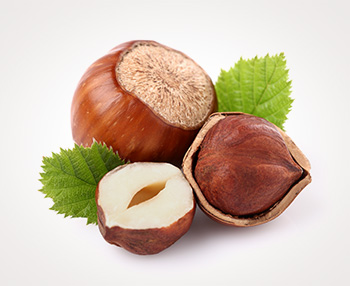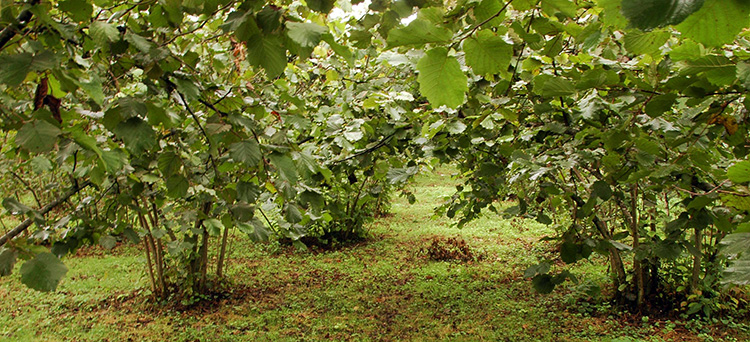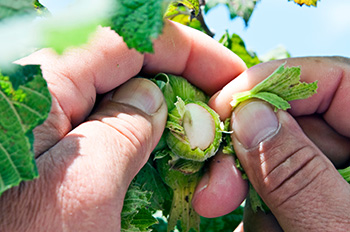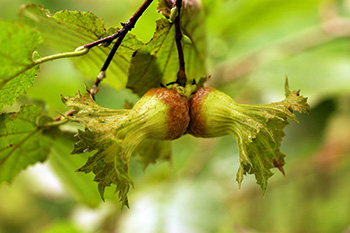Hazelnut Farming Schedule
January
 During this month, female flowers, a.k.a. cloves, starts flourishing on the hazelnut branches. Popping out of a flake-covered bud and boasting fiber-like slim extensions in colors of red, maroon and pink varying by types, these female flowers will each be a hazelnut husk in the future.
During this month, female flowers, a.k.a. cloves, starts flourishing on the hazelnut branches. Popping out of a flake-covered bud and boasting fiber-like slim extensions in colors of red, maroon and pink varying by types, these female flowers will each be a hazelnut husk in the future.
If you want to cultivate a high yield, these cloves must be healthy and be inseminated and protected against cold. In this respect, precautions must be taken in these months against the winter frosts and late spring frosts.
For this purpose, easily flammable, smoke or fume releasing brushwood or similar flammable material must be supplied and piled up in the garden in the dominant windward side usually until the end of March. Once a danger of frost appears, they will be set on fire with easily flammable materials such as kerosene to protect hazelnut garden against frost.
Again in this month, before buds out, pesticides are applied to fight with Lepidosaphes ulmi.
In addition, intertwined and dried branches can be gathered up and set on fire to fight with Anisandrus dispar which is especially seen in sandy soils. This application will be repeated in the next months.
February
Female flowers are fully matured, while male flowers starts spreading their pollens out.
Hazelnut gardens starts appearing like covered with a bright yellow tulle, especially on the days where it does not rain and plus gently breezes. This is the sign that yellow pollens will be carried by the winds reaching cloves and starting the impregnation.
The better the weather conditions in this month, the higher amount of the pollen carried reaching the clove and the better the impregnation, meaning that the product will be abundant in that year.
Of course, it is necessary to nurture well the impregnated clovers to have good and abundant product. For this purpose, burnt farm manure must be introduced by this month. Used once a 3-4 years, farm manure must be introduced in the soil by strictly mixing it in the amount of 25-30 kg right under the branches under the beds.
You should remember that one ton of burnt farm manure contains 5.5 kg of nitrogen, 2.5 kg of phosphor, 5,5-6 kg of potassium and some other plant nutrients, and also improves the composition of the soils.
In this month, it also benefits to burn cones by manually picking them up in order to eliminate the acarina causing damages as well as hazelnut moth which has been living inside the cone during winter.
A better fertilization means more products and more yield.
If you use unburnt farm manure, please note that our garden will not benefit from fertilization sufficiently and may be plagued with other plants such as stinger and blackberry.

March
While the ice-cold weather conditions are seen from time to time, March is the month where the weather and soil starts getting warmer and the living beings starts becoming lively.
Now, the nutrients so much needed by the plant, namely, fertilizers must be introduced into the soil. Especially, half of the recommended amount of the nitrous fertilizers are sprinkled directly under the branches, as is in the farm manure, and then mixed in the soil which is hoed in a depth of 5-10cm. But, before introducing the fertilization, soil analyses must be conducted so that you can avoid under- or over-fertilization.
Mixing the fertilizer with soil by hoeing will both make best use of the fertilizer and ensure an effective fight with various pests which has been living in the soil during winter.
The fight against hazelnut acarina which infests the various buds via pesticides must begin by the end of this month in warmer years, and for fresh stools, when the third leaf from the bottom falls over back.
 The fight against Anoplus roboris with pesticides starts by the beginning of this months, before its larva opens tunnels.
The fight against Anoplus roboris with pesticides starts by the beginning of this months, before its larva opens tunnels.
In this month, precautions must be taken against damages in the gardens with premature foliation due to late frosts in spring.
In the meantime, weeding out the stools and braches which are damaged due to winter conditions must be continued.
While sprinkling the nitrous (summer) fertilizers and farm manures right under the braches 50-60cm away the bottom of beds, it must be hoed ensuring that it thoroughly mixes with soil.
April
Now, hazelnut branches starts producing green leaves, gardens start covered with a lush cloth. Hazelnut husks start heaving into sight by this month.
In general, this is the month where the fight against acarina with pesticide can take place. If there are 30 cone on average per bed and for fresh stools, 3rd leaf from the bottom falls over back, then pesticide application must start immediately. Therefore, a fight with Hazelnut Moth can take place too. Because hazelnut moths lives in the cones during the winter and opens galleries in the fresh developing stools and buds causing them to dry. If pesticide application is repeated 15 days later, the better results will be achieved. Animals must not be allowed in the gardens applied with pesticide for 30 days.
In the recent years, the fight against the matured Palomena prasina which spent the winter in the gardens, an insect known with its damages in the form of amorph kernels with tumor, takes place in the second half of April.
During the early in the morning, 10 beds must be shaken off and if at least 1 mature insect falls down, pesticide must be applied by mixing it with water of 8-10 liter per decare.
If nitrous fertilization is not used yet, it can also be applied in this month. Please note that keeping infant hazelnut on the branch and nurturing it is only in the hand of humans.
The success in agricultural protection is only possible by using the pesticide which is effective on the target pest in recommend dosage and on time.
May
In this month where all living-beings emerged from winter sleep and became active, and hazelnut husks grew large and kernels being formed, the pests of the hazelnut starts giving damages to it. In this respect, a special attention must be paid to the pest control in the May.
The fight against Hazelnut Worm, which is the most common pest infesting the hazelnut, which damage so high that just a pair of it damages around 200 fruits, take place in this month where kernels reached up a size of lentil seed. For this purpose, during early hours in the morning, branches are shaken off on a white cloth of 3x3.5meter and mature Hazelnut Worms are examined. If at least 3 mature pests fall down per 10 beds, pesticide must strictly be applied.
 Even tough there is a wide range of pesticides for hazelnut worms; water-soluble pesticides must be used in order to avoid environmental damages, especially birds and bees. Pesticides must be applied such that it will not cross the crown limits of the bedding and it will cover the reverse face of the leaves. Animals must not be allowed in the garden applied with pesticide for three weeks.
Even tough there is a wide range of pesticides for hazelnut worms; water-soluble pesticides must be used in order to avoid environmental damages, especially birds and bees. Pesticides must be applied such that it will not cross the crown limits of the bedding and it will cover the reverse face of the leaves. Animals must not be allowed in the garden applied with pesticide for three weeks.
The second half of the recommended nitrous fertilizer is applied towards the end of this month as specified for the first half (in March).
In hazelnut gardens, leaf fertilizers containing trace elements, introduced through leaves, are applied for 2-3 times between May and June with a 15-20 days in between and the first application starts towards the end of this month.
No animals must be allowed in the garden applied with pesticides in the specified period and fruits must not strictly be eaten without first thoroughly washing them.
June
In this month, accepted as the start of summer, kernels continued to develop and husks start becoming bigger. Farmer can estimate the yield in that year by looking at the husks developed on the branches, which is the value for his efforts, and starts calculating his earnings.
In the garden, herbicide application against weeds such as stinger, blackberry takes place towards the end of this month.
If the bottom stools in the hazelnut beds have not been cleaned in Autumn, they can also be cleaned in this month.
Pest control with pesticides is proven successful against active 1st period larvae of brown cochineal, which lives on sucking the juice sap of branches weakening the plant and even dries it out. Pesticides must be applied towards the end of June (close to completion of hatching).
Before proceeding to pest control application against this pest, which became extremely widespread, causing frequent complaints of the farmers, you must do a pre-control, by randomly selecting marked 3 infested stools from each 10 beds, namely a total of 30 stools, then if you found 5 alive cochineals in each of them, then you should apply pesticides.
For a successful application, entire leaves, branches and stools must be applied with pesticides.
In this month also fight against Anisandrus dispar with pesticides take place. A tour around garden take place in the half of June in the gardens infested with this pest. Pesticide application must be done if you see fresh wood chips produced by mature female insects which started opening galleries and 15-20 days after the first application, second one must be done.
July
In this month where hazelnut producer is full of hope and joy with his eyes focused on the hazelnut branches, the hazelnut is also full of fruit with an hardened shell.
In some years with lower levels of precipitation, drought may occur. In order to prevent hazelnut garden from this adverse conditions leading to unbalanced water in the plant resulting in fruits with immature kernels and increased wastage before the harvest, irrigation must be applied to the gardens as much as practical.
Now, there is little time to harvest the hazelnuts. In gardens, pre-harvest cleaning must be done, tools and equipment must be repaired, shortages must be made up both at home and the threshing site and threshing site must be prepared.
If nymph concentration of Palomena prasina is excessive, pesticide should be applied. For this purpose, nymph pesticide is applied by adding 50 liter water per decare in any of the pesticides specified for April (but a different one is recommended).
In order to have analysis made for using suitable and sufficient fertilizer in the future, a leaf must be sampled in the second half of this month (10-15 days before harvesting). Soil can be sampled at any time before introducing the fertilizer.
Before proceeding to the fertilization, garden soil and/or hazelnut leaf must be analyzed in order to determine the fertilizer depending on the type and requirement determined.
Thus, excessive use of fertilize is avoided and composition of the soil remains intact.
August
 In this month where hazelnut is harvested, all gardens become populated and cheerful with people from old to young, from women to men, everyone is occupied with the hazelnut.
In this month where hazelnut is harvested, all gardens become populated and cheerful with people from old to young, from women to men, everyone is occupied with the hazelnut.
It is now time to harvest the labor and efforts of the farmer who has been constantly busy with hazelnut for one year. However, for a farmer to be fully rewarded for his one year of effort, hazelnut must have reached up the full maturity for the best yield. Because, harvesting immature hazelnuts causes lower yield, increased crisp resulting in shortened storage times.
It must be remembered that the pre-determined conditions must be observed to protect quality during plucking-off as well as storage of the hazelnut which are picked up by hands on the grounds after having shaken off the branches, which will eventually contribute in the economy of both farmer and our country.
September
In some sites where threshing time delayed, product must be protected well against the autumn rains.
Necessary precautions must be taken in order to protect hazelnuts against damage, which could not be dried earlier or stayed under the plastic cover for a long time.
After completion of the hazelnut harvest, pesticides must be applied against the hazelnut moth. For this, you should check out if brown spots exist in triangle indents where middle vein joins with side vein on the reverse face of the leaves, if there are problems in more than 15 of the 100 leaves we checked out, then pesticide must be applied.
October
In previous month, hazelnuts were picked up, threshing completed and many farmer has sold them and got rewarded for their efforts of one year.
Now, it is time to boost up or at least maintain the yield of next year. Because, October and November are preparation months for the product of next year.
For this, special attention must be paid to pruning. First, dried, broken or less productive branches and even beds must be removed to replace with new young stools. In the meantime, unnecessary stools must be removed.
On the other hand, the time of introducing the phosphorous and potassium fertilizers, so-called winter fertilizers, is also the October-November. Phosphorous fertilizers which are introduced in general 3 times a year, must be used in 20-30 pits to be dug in a depth of 10-15cm right under the branches around the beds.
Again, the fights against larvae of May insect with pesticides starts in September-October. For this, 16 different points of the garden where problems are seen are marked with a 50x50cm frame, which are then dug in a depth of 25cm and the soil taken on a cloth is examined, if there are 3 pieces of larvae in 1m2 (four frames area), then soil must be applied with pesticides.
November
Regarded as the beginning of winter season, in November, if weather permits, removal and cleaning works are continued in the hazelnut gardens. In the sites where winter (phosphorous) fertilization is delayed, it should be applied in this month.
For hazelnut to develop well and produce a bountiful harvest, the fertile soil must have a pH of 5-7. The recommended lime as a result of the soil and leaf analysis is first sprinkled right under the beds and then introduced in the soil by hoeing it in a depth of 5-10cm.
It is recommended not to introduce the lime and recommended winter fertilizers at the same time.
Pesticides for Lepidosaphes ulmi, which is mainly dealt with in May, can also be applied in this month. On the other hand, while dried branches are removed, fight against Anisandrus dispar also continues.
In the sites with heavy winter rains, farm manure can be introduced from this Month up to March. Please note that the best fertilizer is farm manure and these fertilizers contain every sorts of nutrients, which is necessary for the soil.
Although there is less work in November, hazelnut farmer will stay in the garden to cut firewood and to ensure that his animal in his barn have comfortable conditions.
While introducing fertilizer in the soil, do not just sprinkle and leave them on the bottom of beds.
December
It is the month which a hazelnut farmer has the least things to do.
Male flowers on the branches got bigger, buds of cloves got swollen and ready to burst, red tips are sporadically seen.
According to results of soil and leaf analyses, farmer introduces the limes, if weather permits, if he has not yet applied it, and repair fences and trenches.

